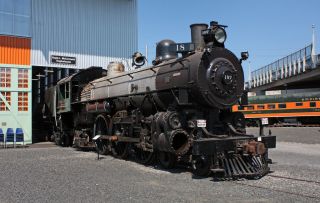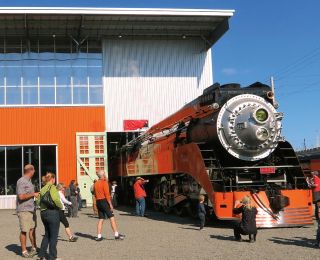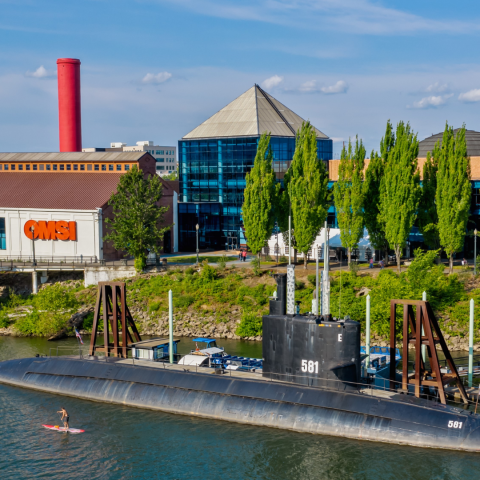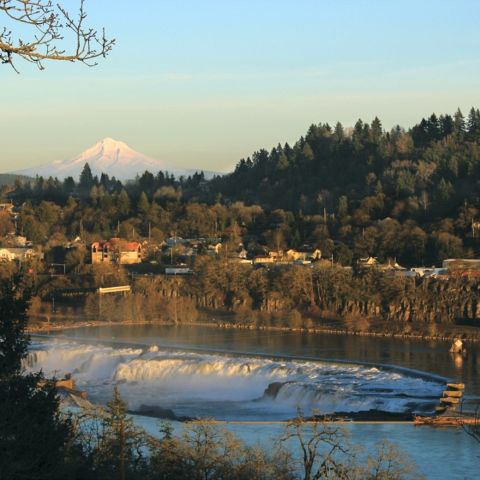
Oregon Rail Heritage Center
This free Central Eastside attraction offers a first-class ticket to railroad history.
Know Before You Go
The Oregon Rail Heritage Center is open on Thursday through Sunday from 1–5 p.m. Visit their site for more information.
Bordered by several modern rail lines — the Portland Streetcar, MAX Light Rail, Union Pacific, and Oregon Pacific — the Oregon Rail Heritage Center celebrates trains of the past.
Opened in September 2012, this free, volunteer-run museum’s modern exhibit space showcases three vintage steam locomotives. Donated to the City of Portland by the Southern Pacific Railroad in 1958, the three steam locomotives originally lived at Oaks Amusement Park until 1974 when they were moved one-by-one to the Brooklyn Roundhouse in Southeast Portland.
Explore Oregon’s Rail Heritage
Where is the Oregon Rail Heritage Center?
When is the ORHC open?
Volunteers run the ORHC, and hours may vary, so check their website to ensure it’s open before your arrival.
What is the difference between a steam train and a locomotive?
How do I ride the Holiday Express?
Since the move, volunteers have spent thousands of hours restoring these locomotives. The Southern Pacific 4449, the Spokane Portland and the Seattle 700 are both operational while the Oregon Rail and Navigation 197 continues to be restored.
The Trains
Southern Pacific 4449
Built in 1941 the SP 4449 is the only remaining operable steam locomotive of the Art Deco era. The 4499 pulled Southern Pacific “Daylight” coaches (once advertised as the most beautiful passenger train in the world with a trendy red, black and orange color scheme) from Los Angeles to San Francisco over the Scenic Coast Route and then on to Portland until 1955. Retired to Oaks Park in 1958 as an outdoor display, it was believed the 4449 would never run again until it was chosen among three other steam locomotives for a complete restoration in 1974 to pull the 1976 Bicentennial Freedom Train throughout the United States.
Spokane Portland & Seattle 700
Built in 1938 the SP & S 700 is an oil-fired engine, an example of latter-year steam locomotives with a more advanced design. SP & S 700 pulled the famous Empire Builder, a long-distance train route that explored the Pacific Northwest from Chicago to Seattle or Portland until it transitioned to diesel power in 1947. It then ran a passenger service from Portland up the Columbia River Gorge to Spokane until 1956, and in 1958 joined the 4499 on display at Oaks Park. Its restoration was completed in 1990 and has been operational ever since.

Credit: Oregon Heritage Rail Center
Oregon Railway & Navigation 197
The oldest of the locomotives on display at OHRC, the OR&N 197, was built in 1905 by Baldwin Locomotive Works for the E. H. Harriman rail empire that later merged into the Union Pacific. Arriving in Portland at the same time as the Lewis & Clark Centennial Exposition, the OR&N 197 was a commercial train, moving goods around the Portland area for over 50 years before retirement in the 1950s. In 1996 the 197 was moved to the Brooklyn Roundhouse from Oaks Park, where it is currently undergoing restoration.
A New Train
Set to pull the Holiday Express in 2023, the Mount Emily Shay #1 has been a dinner train and host of Fourth of July rides in Prineville for over 30 years. Of the 3,000 Shay engines that were originally manufactured and designed for the mining and timber industries, only about 115 still exist today and fewer are considered operational. The Oregon Historical Society has owned the Mount Emily Shay #1 since 1957.

Credit: Oregon Heritage Rail Center
Built at the Lima Locomotive Works in 1920s Ohio, the Mount Emily Shay #1 was originally purchased by a Seattle-based steel company, then sold to a Washington logging company before it was sold again to the Mount Emily Lumber Company in La Grande, Oregon which ultimately gave the engine its name.
“The Mount Emily Shay will allow the Oregon Rail Heritage Center to show the public the important role logging railroads played in the development of the timber industry in Oregon,” Roy Hemmingway, president of the Oregon Rail Heritage Center, said. “Specialty locomotives like the Shay, which could operate on steep and rough track, were able to access timber not available by other means. Shays were key to bringing logs to the mills and developing Oregon’s timber economy.
The Mount Emily Shay will allow the Oregon Rail Heritage Center to show the public the important role logging railroads played in the development of the timber industry in Oregon.
Roy Hemmingway, president of the Oregon Rail Heritage Center
Ride a Train
From Match through September, the ORHC offers themed train rides along the east bank of the Willamette River. Powered by their vintage 1912 Polson #2 steam locomotive, these excursions include comfortable seating, beautiful views, snacks and beverages.
Train lovers also have the chance to book rides on the Oregon Pacific Railroad passenger train every Saturday, which travels between the ORHC and Oaks Bottom Park. Then in December, board the ORHC Holiday Express train for a whimsical winter ride along the Willamette River.

Other Things on View
Machine Shop
Since ORHC actively works to restore and maintain its locomotives, it hosts an array of industrial machining equipment to fabricate or repair parts that are no longer made for these antique trains. As a working museum, visitors might see skilled volunteers work the lathes, presses, sandblasters, saws, and boring machines (devices that enlarge and smooth pre-drilled holes and aren’t boring at all) that were a part of everyday work in a roundhouse.
Brooklyn Turntable
Built in 1924 by the American Bridge Company, the Brooklyn Turntable located in the Central Eastside is a mechanized roundabout designed to spin locomotives 360 degrees. Unable to back up easily, these historic engines rely on the turntable to orient them toward the next task, usually to send them back on their return trip. This slowly-revolving turntable is fully restored, installed at ORHC and should be fully operational by fall 2023.
Museums & History
Brush up on more of Portland's history at these places in and near the city.
OMSI: Portland’s Interactive Science Museum
With its huge exhibit halls, interactive science labs, multiple auditoriums, “After Dark” events and more, the Oregon Museum of Science and Industry (OMSI) lures visitors of all ages.
Bridges of Portland
Learn the history and key features of the city’s 12 Willamette River bridges.
History
To understand the history of Portland, Oregon, it is critical to look back to the original inhabitants. Explore Portland’s Native history, and learn about the transformation of the region into what we see today.
Mentioned Elsewhere Online
Travel Oregon
Friends of the Oregon Zoo Train
Was this page helpful?


